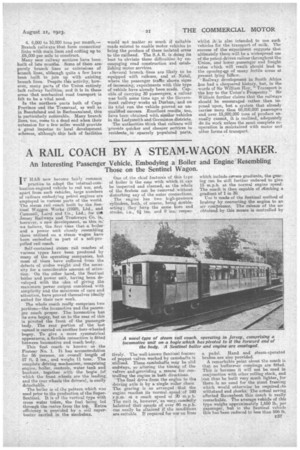A RAIL COACH BY A STEAM-WAGON MAKER.
Page 21

If you've noticed an error in this article please click here to report it so we can fix it.
An Interesting Passenger Vehicle, Embodying a Boiler and Engine Resembling Those on the Sentinel Wagon.
T HAS now become fairly .ecanmon practice to adapt the intetnal-combustion-enginect vehicle to rail use, and, apart from such vehicles, large numbers of railcars embodying petrol engines are employed in various parts of the world. The steam rail coach built by the Sentinel Waggon Works (1920), Ltd., and Cunene, Laird and (io., Ltd., for tilt Jersey Railways and Trarirways Co. is however, a new development, as this is; we believe, the first time that a boiler. and a, power unit closely resembling those utilized on a steam wagon have been embodied as part of a self-propelled rail coach.
self-contained steam rail coaches of various types have been produced by many of the operating companies, but moat of them have suffered from the defects of undue weight and the necessity for a considerable amount of attention. On the other hand, the Sentinel boiler and power unit, having been developed with the idea of giving the maximum power output combined with simplicity and the minimum of care and ettentien, have proved themselves ideally suited for their new work.
The whole coach really comprises two portions—the locomotive and the passenger coach proper. The locomotive has its own bogey, but on to the rear of this is pivoted the front of the passenger body. The rear portion of the last named is carried on another four-wheeled bogey. To give a more symmetrical appearance, a flexible connection is fitted between locomotive and coach body.
This first coach is known as the Pioneer No. 1. It has accommodation for 56 persons, an overall length of 57 ft. 2 ms., and neighs 11 tons. The complete driving mechanism,comprising engine, boiler, controls, water tank and bunkers, together with the bogie (ot.. which the front wheels are the leading:, and the rear wheels the drivers), is easily detachable.
The boiler is of the pattern which was used prior to the production of the SuperSentinel. It is of the vertical type with cross water tubes, the fuel being fed through the centre from the top. Extra efficiency is previded by a coil superheater carried in the smokebox.
One otthe chief features of this type of boiler it the -ease with which it can be inspected and cleaned, as the whole of the firebox can be removed without disturbing any of the outer connections.
The engine has two high-pressure cylinders, both, of course, being doubleacting; they have the same bore and stroke, i.e., 61 ins. and 9 ins. respec tively. The well-known Sentinel feature of poppet valves worked by camshafts is utilized. These cembshafts may be slid
• endways, so altering the timing of the valves andiproviding a means for controlling the engine in bath directions. The final drive•from the engine to the driving axle is by a'single roller chain. The gearing is so arranged that the engine reaches its normal. speed! of 240 r.p.m. at a coach speed of 00 rinp h.• The unit is however,' so very; carefully balanced that speeds of over 40 m.p.h. • can easily be attained if the conditions • are suitable. If required for ligeon lines
which include 'severe gradients, the gearing can be still further reduced to give 15 m.p.h. at the normal engine speed. The coach is then capable of climbing a gradient of 1 in 30. Use is made of the Sentinel method of braking by converting the engine to an air compressor. The release of the air obtained by this means is controlled by a pedal. Hand and steam-operated brakes are also provided. A remarkable point about the coach is that no buffers-tor couplings are fitted. This is because it will not be used in conjunction with other rolling stock, and can thus be built very much lighter, for theta is no need for the stout framing which would otherwise be required sto withstand end shocks. The actual saving effected throughout this coach is really remarkabie. The average vehicle of this type weighs approximately 1,650 lb. per passenger, but in the Sentinel vehicle this ham been reduced to less than 500 lb.




























